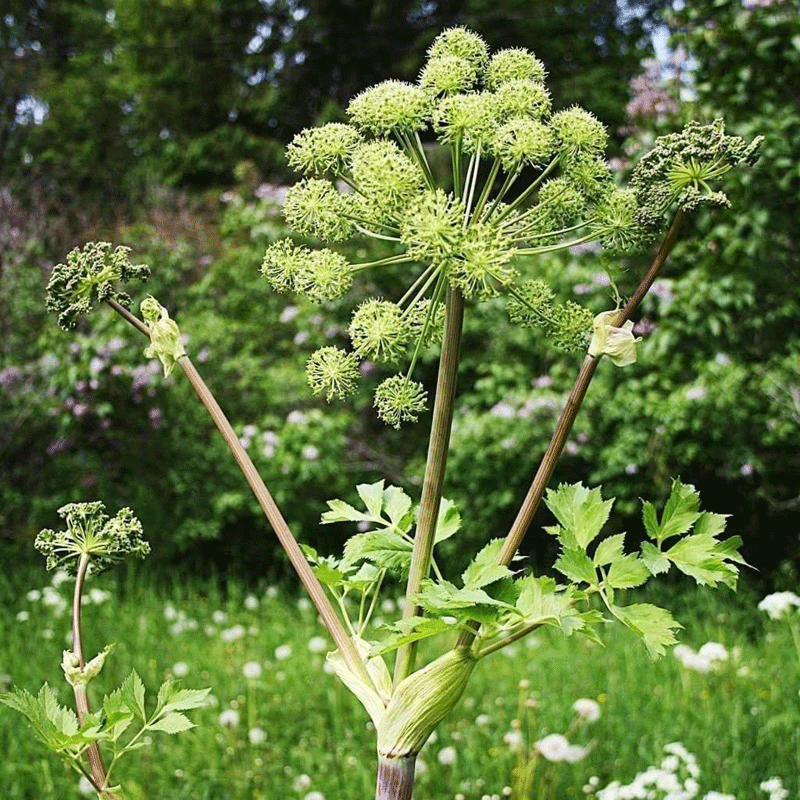Angelica archangelica
Apiaceae (Celery Family)
Type: Biennial
Height: 6 feet
Site: Partial shade
Soil: Moist
Growing Zones: 3–9
In its first year of growth, angelica is an inauspicious mound of broad divided leaves that gives no hint of the drama to come. By its second season, angelica sends up a hard, hollow-stemmed stalk that reaches upward to the sky, unfurling chartreuse umbels of flowers atop its side stems and at its masthead—altogether a spectacular show in early to midsummer. The umbels gradually darken as the oblong seeds develop, ripen, and drop to the ground. The whole plant is strongly aromatic, with a clean, sharp scent of celery and gin, sweetened with a dash of licorice. A native of northern Europe, angelica is best known for flavoring gin and liqueurs, but it also has an ancient history as a medicinal herb for treating digestive disorders and coughs.
Angelica was one of the first herbs that I noticed in Jigs’s little herb collection by the back door when we lived in northern Vermont. Since he didn’t know it is virtually impossible to raise angelica from stored seed (information about growing herbs was hard to come by in the early 1960s), that was the way he grew it. In fact, it was not the first time in our various moves that he had raised it successfully from seed, just the first time I took note of it. I could hardly ignore its dramatic presence, rising up and towering over all the other clumps of herbs, few of which I remember now with such clarity.
Even in the days when I did little to preserve herbs, other than drying bunches of culinary herbs from the vegetable garden, I made angelica candy. This was my first foray into more sophisticated herb use, and it became associated with early summer, when the angelica stems were still young and succulent. Then I would take a little basket and scissors to the backdoor garden and harvest enough stems to use during the winter months for eating out of hand (for their pleasant taste and digestive properties) and for decorating cakes (these would have been an extravagance in those very lean days).
When we moved to Cape Breton and I became seriously involved in raising and using herbs, I naturally wanted to duplicate the angelica of my memories, but it was not easy. I don’t know what magic Jigs used to get his dried seed to germinate, but I had no luck, and only managed to establish the plant from a purchased root.
Because of its size and cultural requirements it has been a challenge to incorporate angelica successfully into a garden setting, to find just the place where it is most happy and shows off to advantage. I have grown it in a variety of places: in the partial shade of an old apple tree; by the damp ground of the compost heap, where it self-seeded among sweet rocket; and even in a container to dwarf its stature. Here it looked quite elegant in an urn-shaped rubber tire turned inside-out (the rim becomes its pedestal), ringed by bright yellow fern-leaved signet marigolds (Tagetes tenuifolia).
Growing
We now know that angelica is one of those plants whose seeds germinate best when they are fresh, before they have been dried and stored. Some growers store seed in moist conditions before sowing to simulate freshness, but I prefer to let nature do the job for me, to allow the plant (established from a piece of root) to ripen and cast its seeds to the ground, where they germinate when conditions are right, in early spring here. If you cut back angelica before it goes to seed, this will prolong its life another year, and new plants can be grown by detaching shoots, which form at its base. Unless you plan to manufacture Angelica candy in a big way, one plant is sufficient for household use. If you have the room, several plants can add distinction to the landscape.
Using
Angelica candy may sound like a lot of work, but it’s really very easy, and if you follow these directions carefully and store the candy in a jar in a cool, dry place away from light, it will last for years and years. Use the stems to decorate cakes or eat them following a meal, like after-dinner mints, to aid digestion. They have a sweet and clean taste. The leftover syrup is delicious in summer fruit cups or over ice cream.


